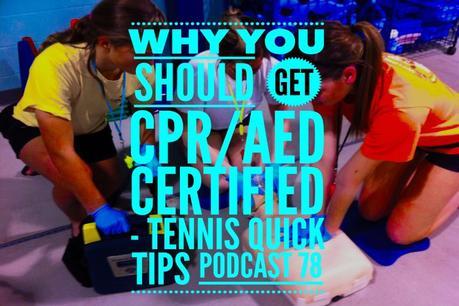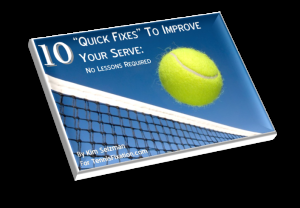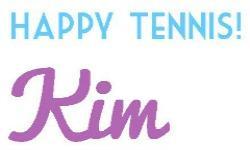Podcast: Play in new window | Download
Here's my public service episode - all about CPR and AED certification. Last summer, I myself became certified and I've just recently gone through a refresher course. It made me realize how important this lifesaving skill is not just on the tennis court, but in everyday life. So in this episode of Tennis Quick Tips, I'm going to tell you why you should get CPR / AED certified. You can listen to this episode by clicking on the media player above or by listening in with your favorite podcast app. You can also subscribe in iTunes by clicking on this link: tennisfixation.com/itunes.

SHOW NOTES:
I think I've mentioned this here but, if not, I became certified as a Tennis Performance Trainer by the International Tennis Performance Association almost a year ago. A Tennis Performance Trainer is someone who is trained in tennis-specific fitness sports science and can work with tennis players of all levels on training, drills and exercise programs to help improve their tennis play and avoid injury. So, yeah, that's me.
What is CPR/AED certification?
One of the requirements for me to become a Tennis Performance Trainer was that I get my CPR/AED certification. CPR, as you probably know, stands for "cardiopulmonary resuscitation" and is a lifesaving technique used when someone stops breathing or their heart stops beating. AED stands for "automated external defibrillator" and is a portable device used to assess a person's heart rhythms and deliver an electrical shock to the heart as needed. So, last summer, I went through an American Red Cross training course here in Houston and became CPR/AED certified. And then, just this week, I took a Red Cross on-line refresher course to help keep me up-to-date on my training.
Why is CPR such an important life-saving skill?
Why is CPR such an important skill for you to have? Because cardiac arrests are much more common than you think and can happen to anyone at any time. According to the American Heart Association, which also teaches CPR classes, 383,000 out-of-hospital sudden cardiac arrests happen each year and 88 percent of all cardiac arrest incidents occur at home. Many victims seem healthy and do not have heart disease or any other risk factor. To be clear, sudden cardiac arrest is not the same as a heart attack. Sudden cardiac arrest occurs when the electrical impulses to the heart become rapid or chaotic, causing the heart to suddenly stop beating. A heart attack happens when the blood supply to part of the heart is blocked. A heart attack may cause cardiac arrest. But cardiac arrest can occur without a heart attack.
When sudden cardiac arrest occurs, the response needs to be rapid. But, the American Heart Association says that up to 70 percent of Americans feel helpless to act during a cardiac emergency because they either don't know how to administer CPR or their skills are inadequate. Furthermore, up to 88 percent of all cardiac arrests occur at home. The bottom line - even if you don't believe knowing CPR is important for you as a tennis player, it is important for you to help keep your family members alive and healthy.
Medical Emergencies on the Tennis Court
The reason I'm bringing all of this up here is not to teach you CPR, because I certainly am not qualified to do that. Rather, I'm bringing this up because going through the course made me realize just what a critical skill this is and how important it would be to have someone qualified to administer CPR, not just on a tennis court, but in any situation where there's a medical emergency. I myself have witnessed someone having a heart attack on a tennis court so I know it's possible. And I'm sure many of you have been in the same or a similar situation, where a medical emergency was occurring on court and someone needed to act before emergency medical personnel could arrive. The American Heart Association claims that effective bystander CPR provided immediately after sudden cardiac arrest can double or even triple a victim's chance of survival. So, again, being trained in CPR is incredibly important.
CPR/AED Training is Simple and Easy
So, while I'm not going to train you in CPR, I did want to give you some information about the process and what I went through to show you just how simple it is and how valuable:
1. CPR/AED training is so simple to do. Maybe you remember having to learn CPR years ago and how it was a long-involved all-day process. Well, my training was not like that at all. As I said, I did my training through the Red Cross and the "classroom" portion of the training was all on-line. I went through several training modules with follow-up quizzes and, as long as I passed the quizzes with an acceptable grade, I was not required to attend any kind of in-class lecture type training. And the on-line training was easy to follow with lots of videos to explain and show exactly what was required.
2. The "hands-on" portion of the training was quick and easy and very useful. After passing the on-line portion of the training, I did have to attend a hands-on training session where I actually worked with other students, the CPR dummies and AED machines. This took just a few hours and really gave me the experience to feel confident in the CPR and AED skills. Plus, the Red Cross trainer was so impressive and made me appreciate just what that organization does for people.
3. There is no reason to be afraid of an AED device. To be honest, the thing I was most worried about with my training was using an AED. I have never even seen one before, other than one hanging on a wall somewhere, and was very concerned that I would not be able to properly use one or that I might hurt myself or the person I was trying to help by trying to use one. My training put all of my concerns to rest. These little life-saving machines are incredible as they have a recording that speaks to you and guides you through every step of using one. You do not need to memorize a bunch of complicated steps or worry that you will hurt someone my using an AED. The machine just won't let you do that.
4. There are several ways to avoid coming into direct contact with a victim when giving CPR. This might be a concern for you because it was for me. But I learned that there are now these face shields that you can use when giving breaths to someone during CPR that prevent you from having direct contact with their mouth and possibly getting some type of communicable disease from them. I have been meaning to buy one of these to throw in my tennis bag and, because I'm doing this podcast and saying this, I'll now be sure and do it. Just in case someone ever ask me if they can see it when I'm out playing tennis. These face shields are just sheets of plastic and a mouth guard that you can give breaths through. I'll put a link in the show notes to this episode showing where you can order these face shields on-line. If that bothers you, there is also a form of CPR called hands-free or compression-only CPR that does not involved giving breaths. I didn't get trained in this type of CPR but have read about it and it can be just as effective as regular CPR in some situations.
5. My on-line refresher course was really valuable. One of the biggest concerns I have and I think anyone would have is, am I going to remember how to give CPR if the time ever comes that I need to help? The Red Cross recommends that you refresh your skills every three months or so to make sure you remember exactly how to do it. And, while I don't think I would go to a refresher course every three months, I did just complete the Red Cross on-line refresher course and it was fantastic. It really helped me to remember exactly how to do CPR and use an AED and took me less than 30 minutes to complete - something I can see myself doing every three months or so.
6. The American Red Cross has an excellent and free First Aid app to download. If you decide you're not going to get CPR/AED certfied, I strongly suggest you download the Red Cross First Aid app to your smart phone. There are versions for the iPhone and for Android devices and you can find it by searching for "Red Cross First Aid." You'll see they have a number of great apps you can get for free but I really like this First Aid app as it will walk you through, step-by-step, exactly what to do in numerous emergency situations including if someone has a heart attack or if they are unconscious and not breathing. I'll link to the web page for the app in the show notes so you can easily find it for your own phone.
So, that's my public service announcement podcast episode. Get out there and get CPR certified! I'll have lots of links in the show notes for this episode so you can easily find CPR and first aid classes in your community if you live in the United States. If you live outside the U.S., then I suggest you either go on-line and find out what the Red Cross in your area offers or give them a call as I know they teach these classes in countries all over the world. I'll also have links to where you can buy the face shields I mentioned and I will, finally, buy one myself for my tennis bag so if you see me out on the courts, be sure and ask me about it.
Are you CPR certified? Have you been involved in an on-court medical emergency? I would really appreciate it if you could comment on the show notes as to what you did or saw done that helped in such a situation. Just go to the show notes and you'll see the comment section at the bottom of the page.
RESOURCES AND LINKS FROM THIS EPISODE:
Note: These are not affiliate links. I do not receive any kind of commission or benefit if you use these links to buy a product.SHARE, SUBSCRIBE AND REVIEW:
Feel free to share this episode by sending people to:
You can listen in, subscribe or leave a review by going to:
GET A BETTER SERVE FAST!
And if you're interested in getting a better serve - fast! - get my free ebook, 10 Quick Fixes to Improve Your Serve: No Lessons Required.

By applying the 10 simple tips to your serve that I give in this ebook, your serve can become a tool that you can use to gain control of points. It can become more powerful, more accurate, and something you're actually proud of. Just enter your email below and you'll get instant access to this free ebook as well as weekly updates with all of my best tennis tips!

© Kim Selzman 2015 All Rights Reserved

